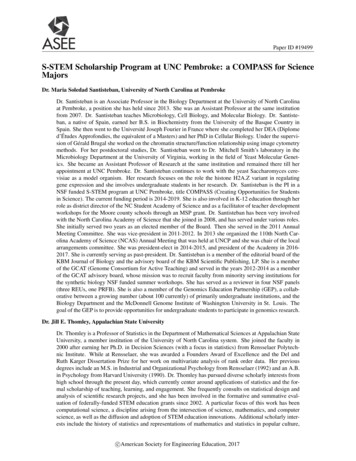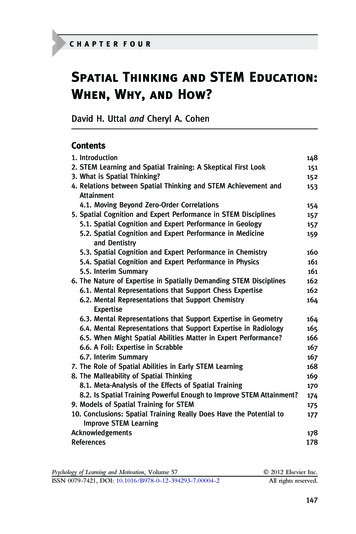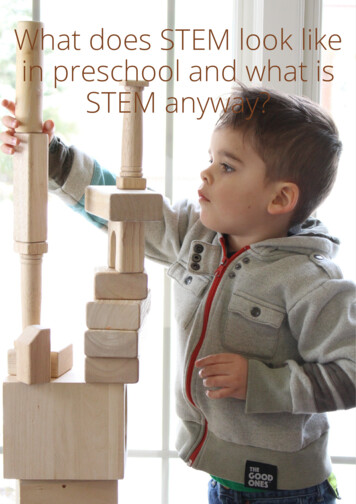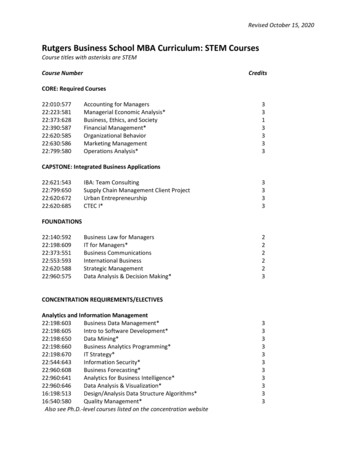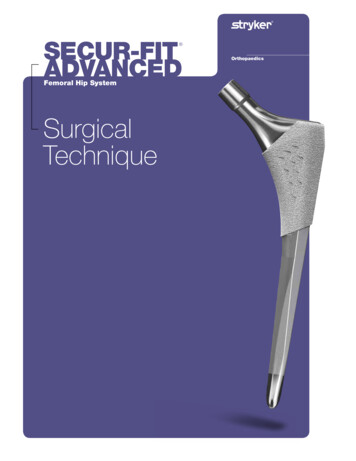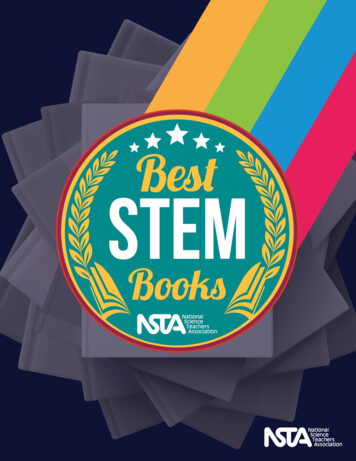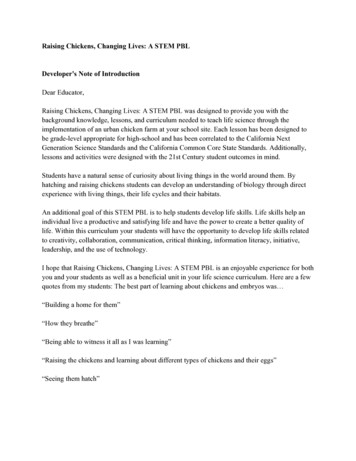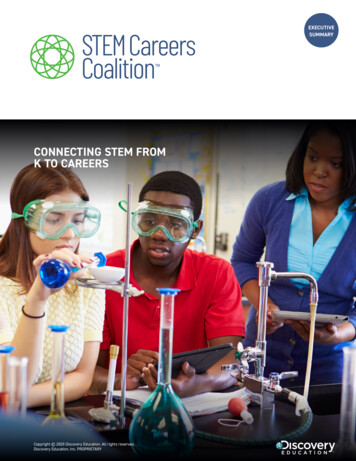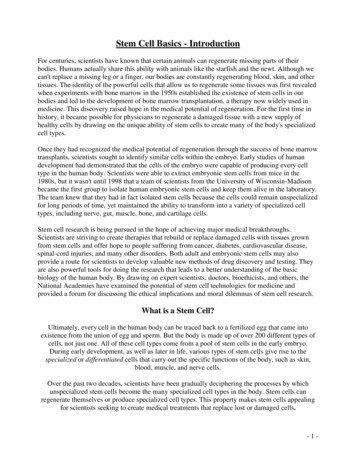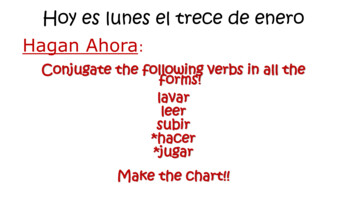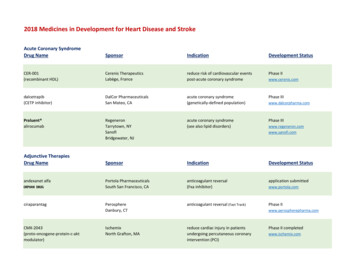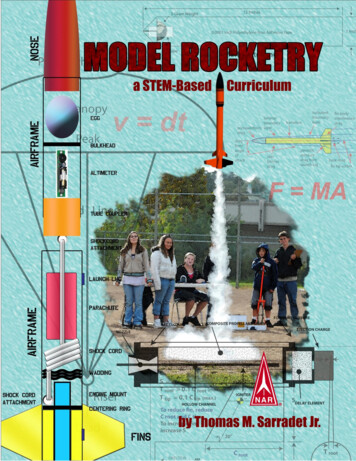
Transcription
1A STEM BASED MODEL ROCKETRY CURRICULUM:FOR THE TEAM AMERICA ROCKETRY CHALLENGEThomas M. Sarradet, Jr.B.F.A., University of Louisiana, Lafayette, 1980PROJECTSubmitted in partial satisfaction ofthe requirements for the degree ofMASTER OF ARTSinEDUCATION(Educational Leadership & Policy Studies)atCALIFORNIA STATE UNIVERSITY, SACRAMENTOFALL2009
2TABLE OF CONTENTSCHAPTER 1 INTRODUCTION. 6Description . 7Setting . 7Limitations of Model Rocketry . 7CHAPTER 2SKILLS AND STANDARDS . 8Introduction . 8Skills Set. 8List of Lessons . 10STEM Standards . 11CHAPTER 3 LESSONS . 23Lecture and Demonstration . 23LD01: Introduction to Rocketry . 24LD02: The Model Rocket. 25LD03: Newton‟s Laws of Motion . 26LD04: Aerodynamics . 27LD05: Rocket Stability. 28LD06: Launch Procedures . 29LD07: TARC Rules . 30LD08: Model Rocketry Rules . 31Notes to Lecture & Demonstration Lessons . 32LD01: Introduction to Model Rocketry . 32LD02: The Model Rocket. 34LD03: Newton‟s Laws of Motion . 42LD04: Aerodynamics . 44LD05: Rocket Stability. 47Design and Engineering . 50DE01: Introduction to Rocksim. 51
3DE02: The Booster Section . 52DE03: The Payload Section . 53DE04: Painting and Finishing . 54DE05: Rocket Engines . 55DE06: Recovery Systems . 56DE07: Model Rocket Launch Equipment . 57Construction . 58C01: Model Rocket Parts Inventory . 59C02: Model Rocket Construction: The Motor Mount . 60C03: Model Rocket Construction: Fins, Airframe, Nose . 61C04: Model Rocket Construction: Payload Bays . 62C05: Model Rocket Construction: Finishing . 63C06: Recovery Systems. 64Investigation and Discovery . 65ID01: Data Collecting Instruments . 66ID02: Investigating Parachutes. 67ID03: Calculating Apogee . 68ID04: Adjusting Apogee . 70ID05: Adjusting Descent Rate Using Parachutes & Streamers . 71ID06: Investigating Average Velocity. 72ID07: Investigating Energy . 73ID08: Investigating Nose Drag Co efficiency . 74ID09: Investigating Streamers . 75ID10: Investigating Weathercocking . 76ID11: Entering and Analyzing Flight Data in Rocksim . 77ID12: Determining the Center of Pressure . 78D13: Determine the Center of Gravity and Stability of a Rocket . 79ID14: Basic Meteorology . 80
4CHAPTER 4 TRAINING, ORGANIZATION, AND EQUIPMENT . 81Description of Positions . 84Assignment Recommendations . 89Duty Rotation . 90Training . 90Launch Site. 91Equipment . 91Design and Engineering Equipment . 91Construction Equipment and Material. 92Launch Equipment . 92Data Collection Equipment . 94APPENDIX 1: COUNTDOWN PROCEDURES . 96APPENDIX 2: ENGINEER CHECKLIST . 98APPENDIX 3: FLIGHT LOG. 99APPENDIX 4: METEOROLOGIST WORKSHEET . 100APPENDIX 5: RECOMMENDED REFERENCE LIBRARY . 101REFERENCES . 102
5Questions or comments may be sent toTom SarradetE.V. Cain Middle School150 Palm Ave.Auburn, CA 95603Email: tsarradet@auburn.k12.ca.us
6CHAPTER 1 INTRODUCTIONSince the publication of A Nation at Risk in 1981, there has been a steadyprogression toward standards based education. The researcher found common languagein many of the standards publications. The authors of those documents saw a need forintegrated curricula that taught several disciplines, such as math and science, in onecurriculum. They saw a benefit not only in time management but also in a betterunderstanding of the content by the students. The authors also saw the advantages ofmore hands-on activities instead of classroom lectures. Math and science is about usingthose disciplines to make things and to solve problems. It is not about taking tests andhearing lectures.There is a strong need for the educational community to embrace these conceptsand move out of the classrooms into the field for a real-world learning experiences. Thepopularity of national competitions may be offered as proof that students are just aswilling to embrace an interactive approach to learning.Model rocketry is a powerful tool for teachers who wish to incorporate science,technology, engineering, and math into a fun, engaging, and challenging activity. Whendesigning model rockets in the computer lab, the students have an opportunity to matchtheir ingenuity with the limits of Newton‟s Laws of Physics in order to design their ownmodel rocket that is aerodynamically sound. Fine motor skills are honed during theconstruction of the rockets as they measure, cut, and glue their rocket parts to thespecifications that they themselves determined. Teamwork is a skill that they acquire andthey organize into a group with many specialized responsibilities for the purpose oflaunching their rockets and collecting valuable data to be processed and analyzed in theclassroom. Suddenly, the Pythagorean Theorem makes sense as they visualize the gianttriangle formed by the flight path of their rocket. Newton‟s Laws are in full enforcementright before their very eyes. Through the activities of model rocketry, science and mathnot only exist, they “come to life.”
7DescriptionThe primary purpose of this curriculum is to teach the STEM skills necessary formiddle and high school students to successfully compete in the Team America RocketryChallenge.SettingThe curriculum may also be used, in whole or in part as: a training program for TARC member. an elective class in middle and high school. an extracurricular course. A model rocket club curriculum. a hands-on activity for a middle or high school science or math class. a summer camp program.Limitations of Model RocketryLaunching model rockets require access to a launch area that meets the sizerequirements in accordance with the Model Rocket Safety Code. Schools typically haveathletic fields that meet Type A and B model rocket motor requirements of 122 squaremeters. The Educator may also contact their local National Association of Rocketry clubfor access to the club‟s launch sites. NAR clubs support local rocketry education effortsand will usually welcome students on their launch sites with proper notification andpreparation. Educators may find club information on the NAR website (NationalAssociation of Rocketry, 2009). The local fire laws should be investigated prior to the useof solid propellants. If laws do prohibit them, the curriculum may be altered to use wateror air as a means of propulsion. Water rockets can be set up to deploy a recovery systemand to carry payloads and electronic altimeters. Educators who use this curriculum fortraining a TARC team should conduct the training prior to the teams beginning theirdesign and build. Once the students begin the contest, educators and mentors areprohibited from aiding in the design and construction of a TARC rocket.
8CHAPTER 2 SKILLS AND STANDARDSIntroductionThe first step in creating a STEM based model rocketry curriculum was to identify theskills students need in order to be successful in the Team America Rocketry Challengeand group them into a skill set. Lessons were designed to teach the targeted skills. Thefinal step was to review federal and state STEM content standards that would beaddressed be the lessons.Skills SetThe following matrix matches specific skills with the lessons that target them.TARC SKILL SETSETStudents should have knowledge of:1. the rules and regulations governing the Team America RocketryChallenge.2. the parts of a model rocket and their function:a. Rocket partsb. Rocket motorsc. Recovery systemsLESSONLD07LD023. Newton‟s Laws of Motion.LD034. basic aerodynamics pertaining to rocket flight.LD04, LD055. math concepts that pertain to the design, construction, and flight ofa model rocket.DE02, DE03,ID03, ID06,ID08, ID12,ID13ID01, ID106. basic meteorology and its influence on rocket flight.7. construction tools and adhesives used to build and repair modelrockets.8. model rocket construction materials and techniques.C01-049. the math and science of parachute and streamer recovery.ID02, ID0910. rocketry safety rules and how to adhere to them.LD08C01-04
9Students should have the skills to:11. operate and succeed in a team environment.LD0812. design a payload model rocket using Rocksim.DE0113. run computer simulations of the rocket‟s flight to ensure sounddesign and that the design meets the requirement of the TARC.14. calculate the proper size and dimensions of rocket parts andmanufacture them to those specifications.15. build an aerodynamically sound booster section, to include arecovery system, to the specifications of the design that withstandsthe stresses of multiple mid-power flight.16. build an aerodynamically sound, multi-chambered payload sectionto the specifications of the design that is capable of protecting theegg and electronic payload.17. determine and adjust model rocket stability.DE0118. safely launch a model rocket and recover it.DE07, LD0619. calculate a rocket‟s velocity in flight.ID0620. calculate the altitude attained by a rocket in flight.ID0321. install and use parachutes and streamers to recover the payload andbooster sections.22. record and analyze flight data in order to make adjustments.DE06, ID02,ID09LD04, ID01,ID04LD03, DE05,ID03, ID07LD03, ID03,ID08LD04, DE06,ID02, ID05,ID09ID0123. predict and adjust a rocket‟s altitude by using rocket motors withvarious Newtons of force.24. predict and adjust the rocket‟s altitude by adjusting the rocketsmass.25. predict and adjust the flight times by adjusting the recoverysystem.26. use the proper equipment to collect, interpret and predict theeffects of atmospheric conditions on rocket flight.27. calculate a rocket‟s altitude and flight time based on atmosphericconditions.28. analyze preliminary flights to redesign and improve their modelrocket as needed.LD04, LD05,DE02, DE03LD04, LD05,DE02, DE04,CO1-06LD04, LD05,DE02, DE04LD05IDO1, ID10ID01-13
10List of LessonsLecture & DemonstrationIntroduction to RocketryLD01The Model RocketLD02Newton‟s Laws of MotionLD03AeronauticsLD04Rocket StabilityLD05Launch ProceduresLD06TARC RulesLD07Model Rocketry RulesLD08Design & EngineeringRocksimDE01The Booster SectionDE02The Payload SectionDE03Painting and FinishingDE04Rocket EnginesDE05Recovery SystemsDE06Launching a Model RocketDE07ConstructionModel Rocket Building PreparationC01Motor MountC02Fins, Airframe, NoseC03Payload BaysC04FinishingC05Recovery SystemsC06Investigation & DiscoveryData Collecting InstrumentsID01Investigating ParachutesID02Calculating ApogeeID03Adjusting ApogeeID04Adjusting Descent Rate Using Parachutes & StreamersID05Investigating Average VelocityID06Investigating EnergyID07Investigating Nose Cone Drag Co efficiencyID08Investigating StreamersID09Investigating WeathercockingID10Adding and Analyzing Data in RocksimID11Determining Center of PressureID12Determining Center of GravityID13Basic MeteorologyID14
11STEM StandardsListed are national and state standards that the researcher has identified as standards thatmay be taught through the use of this curriculum. Each listed standard is matched withthe TARC skills and the lessons that apply to it. Some standards are addressed by most ofthe lessons, but for the sake of clarity the researcher chose to identify a select few asexamples. Standards that the researcher determined do not directly apply to modelrocketry have been omitted; therefore this is not a complete list of the standards.The model rocketry curriculum is not intended to replace science or math courses, butrather to enhance and reinforce them.NATIONAL AND CALIFORNIA STEM STANDARDS: SCIENCENational Science Education StandardsContent Standards: 5-8As a result of activities in grades 5-8, all students should developA Abilities necessary to do scientific inquiry Understand about scientific inquiryB an understanding of Motions and forces Transfer of energyEGABE Abilities of technological designUnderstandings about science and technologyan understanding of Science as a human endeavor Nature of science History of scienceContent Standards: 9 - 12As a result of activities in grades 9 - 12, all students should develop Abilities necessary to do scientific inquiry Understandings about scientific inquiryan understanding of Motions and forces Abilities of technological designUnderstanding about science and 5DE02DE04C01-06
12Gdevelop an understanding ofAll Science as a human endeavor Nature of scientific knowledge Historical perspectivesProgram StandardsB The program of study in science for all students should be developmentallyAllappropriate, interesting, and relevant to students‟ lives; emphasize studentunderstanding through inquiry; and be connected with other school subjects.C The science program should be coordinated with the mathematics program toAllenhance student use and understanding of mathematics in the study of scienceand to improve student understanding of mathematics.California State Standards for Grade 8 SCIENCE (Physical Science)Standard Set 1. Motion1. The velocity of an object is the rate of change or its position.a. position is defined relative to some choice of standard reference point and a4set of reference directions.b. average speed is the total distance traveled divided by the total time elapsed.19c. The speed of an object along the path traveled can vary.d. how to solve problems involving distance, time, and average speed.19e. to describe the velocity of an object one must specify both direction and4speed.f.changes in velocity can be changes in speed, direction, or both.4g. how to interpret graphs of position versus time and speed versus time for4motion in a single direction.Standard Set 2. Forces2. Unbalanced forces cause changes in velocity. Students knowa. a force has both direction and magnitude.34b. when an object is subject to two or more forces at once, the effect is the4cumulative effect of all the forces.c. when the forces on an object are balanced, the motion of the object does not3change.17d. how to identify separately two or more forces acting on a single static object,3including gravity, elastic forces due to tension or compression in matter, andfriction.e. when the forces on an object are unbalanced the object will change its motion3,(that is, it will speed up, slow down, or change direction).4,17f.the greater the mass of an object the more force is needed to achieve the same3change in ID08Standard Set 9. Investigation and ExperimentationAs a basis for understanding this concept, and to address the content the other three strands,students should develop their own questions and perform investigations. Students will:plan and conduct a scientific investigation to test a hypothesis.AllAll
13b.evaluate the accuracy and reproducibility of data.23242526c.distinguish between variable and controlled parameters in a test.23242526d.recognize the slope of the linear graph as the constant in the relationship y kxand apply this to interpret graphs constructed from data.construct appropriate graphs from data and develop quantitative statementsabout the relationships between variables.apply simple mathematical relationships to determine one quantity given theother two (including speed distance/time, density mass/volume, force pressure x area, volume area x height).High School PhysicsMotion and ForcesNewton‟s laws predict the motion of most objects. As a basis forunderstanding this concept:Students know how to solve problems that involve constant speed and averagespeed.Students know that when forces are balanced, no acceleration occurs; thus anobject continues to move at a constant speed or stays at rest (Newton‟s firstlaw).Students know how to apply the law F MA to solve one-dimensional motionproblems that involve constant forces (Newton‟s second Students know that when one object exerts a force on a second object, thesecond object always exerts a force of equal magnitude and in the oppositedirection (Newton‟s third law).Students know the relationship between the universal law of gravitation andthe effect of gravity on an object at the surface of Earth.Students know applying a force to an object perpendicular to the direction ofits motion causes the object to change direction but not speed (e.g., Earth‟sgravitational force causes a satellite in a circular orbit to change direction butnot speed).420214
14g.Students know circular motion requires the application of a constant force17LD05directed toward the center of the circle.h. Students know Newton‟s laws are not exact but provide very good3LD03approximations unless an object is moving close to the speed of light or is23ID04small enough that quantum effects are important.i.Students know how to solve two-dimensional trajectory problems.19ID06Conservation of Energy and Momentum2. The laws of conservation of energy and momentum provide a way to predict and describe themovement of objects. As a basis for understanding this concept:a. Students know how to calculate kinetic energy by using the formula23LD032DE05E 1/2mv .ID03ID07c. Students know how to solve problems involving conservation of energy in25LD04simple systems, such as falling objects.DE06ID02ID05ID09d. Students know how to calculate momentum as the product mv.19ID06e. Students know momentum is a separately conserved quantity different from23ID04energy.f.Students know an unbalanced force on an object produces a change in its4LD04momentum.17LD0526ID01NATIONAL STEM STANDARDS: TECHNOLOGYInternational Technology Education Association StandardsStandard 8: Students will develop an understanding of the attributes of design. Students should learnthatE. Design is a creative planning process that leads to useful products andAllAllsystems. The design process typically occurs in teams whose memberscontribute different kinds of ideas and expertise.F.There is no perfect design. All designs can be improved.28G.Requirements for design are made up of criteria and constraints.1C01C06ID01ID13LD07H.The design process includes defining a problem, brainstorming, researchingand generating ideas, identifying criteria and specifying constraints, exploringpossibilities, selecting an approach, developing a design proposal, making amodel or prototype, testing and evaluating the design using specifications,refining the design, creating or making it, and communicating processes andresults.The design needs to be continually checked and critiqued, and the ideas of thedesign must be refined and improved.Requirements of a design, such as criteria, constraints, and efficiency,sometimes compete with each other.AllAll2227AllID0113AllJ.K.
15Standard 9: Students develop an understanding of engineering design. Students should learn thatF. design involves a set of steps, which can be performed in different sequences15C01and repeated as needed.16C06 Each design problem is unique and may require different procedures ordemand that the stops be performed in a different sequence. In addition,engineers and designers also have their preferences and problemsolving styles and may choose to approach the design process indifferent ways.G. brainstorming is a group problem-solving design process in which each person11LD08in the group presents his or her ideas in an open forum. In this process, no person is allowed to criticize anyone else‟s ideasregardless of how inane they may seem. After all of the ideas arerecorded, the group selects the best ones, and then further developsthem.H. modeling, testing, evaluating, and modifying are used to transform ideas into11DE01practical solutions.28-07C01 Historically, this process has centered on creating and testing06physical models. Models are especially important for the design ofID01large items, such as cars, spacecraft, and airplanes because it is13cheaper to analyze a model before the final products and systems areactually made. Evaluation is used to determine how well the designsmeet the established criteria and to provide direction for refinement.Evaluation procedures range from visually inspecting to actualoperating and testing products and systems.I.Established design principles are used to evaluate existing designs, to collect12DE01data, and to guide the design process.14DE0215DE03 The design principles include flexibility, balance, function, and16LD04proportion. These principles can be applied in many types of designLD05and are common to all technologiesC0106J. Engineering design is influenced by personal characteristics, such as1LD07creativity, resourcefulness, and the ability to visualize and think abstractly. Individuals and groups of people who possess combinations of thesecharacteristics tend to be good at generating numerous alternativesolutions to problems. The design process often involves a groupeffort among individuals with varied experiences, backgrounds, andinterests. Such collaboration tends to enhance creativity, expand therange of possibilities, and increase the level of expertise directedtoward design problems.K. A prototype is a working model used to test a design concept my making11DE01actual observations and necessary adjustments.28-07Prototyping helps to determine the effectiveness of a design be allowing aC01design to be tested before it is built. Prototypes are vital to the testing and06refinement of a product or system with complicated operationsID0113Standard 10: Students will develop an understanding of the role of troubleshooting, research anddevelopment, invention and innovation, and experimentation in problem solving. Students shouldlearn thatF. Troubleshooting is a problem-solving method used to identify the cause of a28ID01malfunction in a technological system.13G Invention is a process of turning ideas and imagination into devices andAllAllsystems. Innovation is the process of modifying an existing product or systemto improve it.
16H.Some technological problems are best solved through experimentation.18ID012813J. Technological problems must be researched before they can be solved.18ID012813Standard 11: Students will develop abilities to apply the design process. Students should be able toH. Apply a design process to solve problems in and beyond the laboratory15C01classroom.16C06I.Specify criteria and constraints for the design.1LD07J. Make two-dimensional and three dimensional representations of the designed12DE01solution.15C0116C06 Two-dimensional examples include sketches, drawings, andcomputer-assisted designs (CAD).K. Test and evaluate the design in relation to pre-established requirements, such1LD07as criteria and constraints, and refine as needed.23DE0325ID04L. Make a product or system and document the solution.2C013C0615LD0416LD0724DE0525DE06ID02ID09M Identify the design problem to solve and decide whether or not to address it.28ID01.13N. Identify criteria and constraints and determine how these will affect the design1LD07process.O. Refine a design be using prototypes and modeling to ensure quality,28ID01efficiency, and productivity of the final product.13Evaluate proposed or existing designs in the real world. Modify the designsolution so that it more effectively solves the problem.P. Evaluate the design solution using conceptual, physical, and mathematical2LD02models at various intervals of the design process in order to check for proper12DE01design and to note areas where improvements are needed.22ID01ID04Standard 13: Students will develop the abilities to assess the impact of products and systems.Students should be able toF. Design and use instruments to gather data.22ID01G. Use data collected to analyze and interpret trends in order to identify the28ID01positive or negative
17. determine and adjust model rocket stability. LD05 18. safely launch a model rocket and recover it. DE07, LD06 19. calculate a rocket‟s velocity in flight. ID06 20. calculate the altitude attained by a rocket in flight. ID03 21. install and use parachutes and streamers to recover the payload and booster sections. DE06, ID02, ID09
